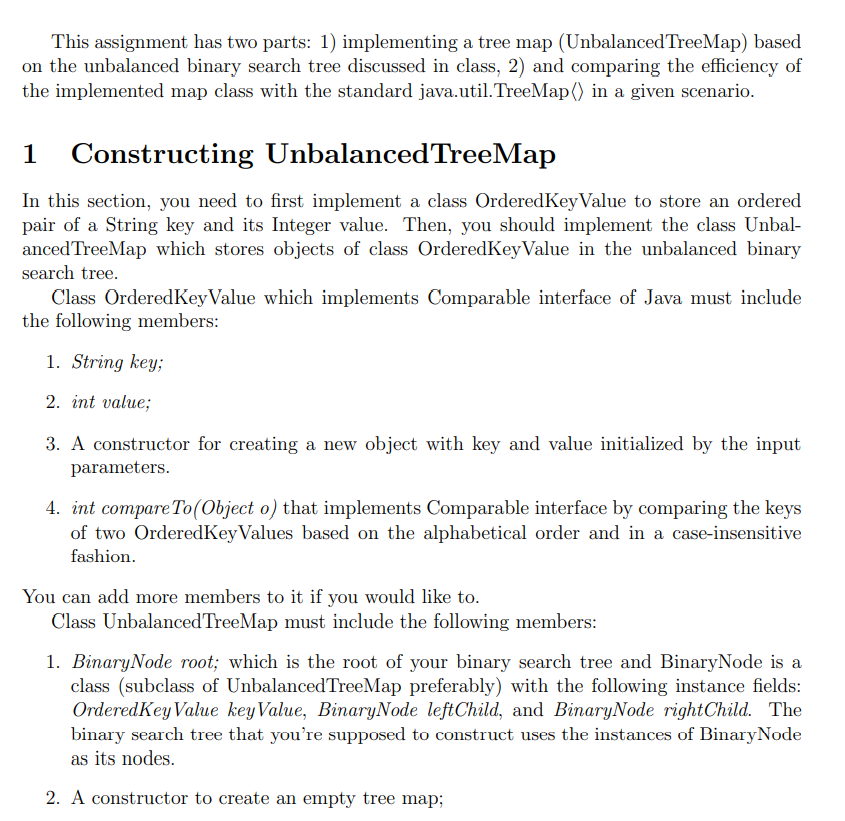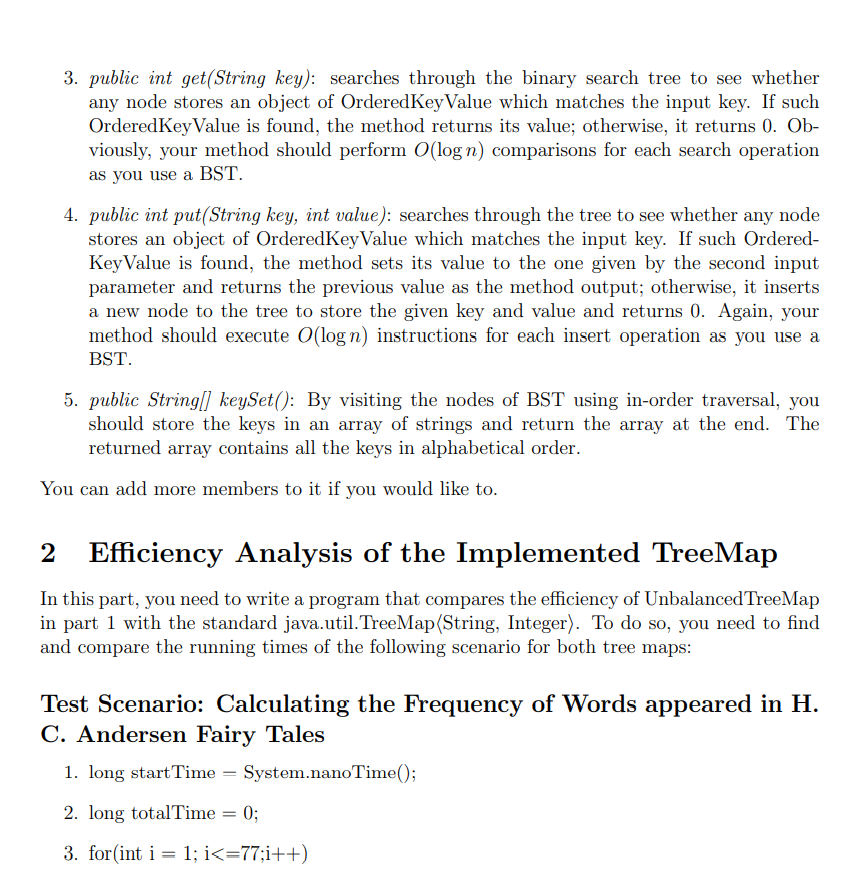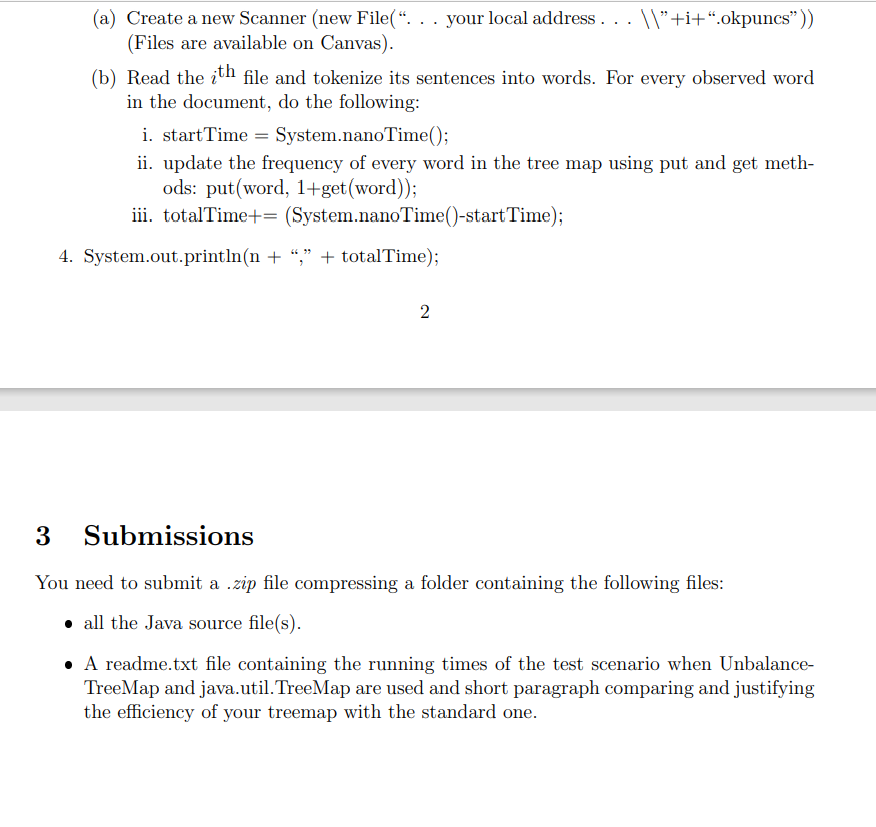Answered step by step
Verified Expert Solution
Question
1 Approved Answer
Already constructed the UnbalancedTreeMap just stuck with the Analysis. -- Step 2 This is only one question using java, please do not avoid. This assignment
Already constructed the UnbalancedTreeMap just stuck with the Analysis. -- Step 2
This is only one question using java, please do not avoid.



This assignment has two parts: 1) implementing a tree map (Unbalanced TreeMap) based on the unbalanced binary search tree discussed in class, 2) and comparing the efficiency of the implemented map class with the standard java.util. TreeMap() in a given scenario. 1 Constructing Unbalanced TreeMap In this section, you need to first implement a class OrderedKeyValue to store an ordered pair of a String key and its Integer value. Then, you should implement the class Unbal- anced TreeMap which stores objects of class OrderedKeyValue in the unbalanced binary search tree. Class Ordered KeyValue which implements Comparable interface of Java must include the following members: 1. String key; 2. int value; 3. A constructor for creating a new object with key and value initialized by the input parameters. 4. int compare To(Object o) that implements Comparable interface by comparing the keys of two OrderedKeyValues based on the alphabetical order and in a case-insensitive fashion. You can add more members to it if you would like to. Class Unbalanced TreeMap must include the following members: 1. BinaryNode root; which is the root of your binary search tree and BinaryNode is a class (subclass of Unbalanced TreeMap preferably) with the following instance fields: Ordered KeyValue keyValue, BinaryNode leftChild, and BinaryNode rightChild. The binary search tree that you're supposed to construct uses the instances of BinaryNode as its nodes. 2. A constructor to create an empty tree map; 3. public int get(String key): searches through the binary search tree to see whether any node stores an object of OrderedKeyValue which matches the input key. If such Ordered Key Value is found, the method returns its value; otherwise, it returns 0. Ob- viously, your method should perform O(log n) comparisons for each search operation as you use a BST. 4. public int put(String key, int value): searches through the tree to see whether any node stores an object of OrderedKeyValue which matches the input key. If such Ordered- KeyValue is found, the method sets its value to the one given by the second input parameter and returns the previous value as the method output; otherwise, it inserts a new node to the tree to store the given key and value and returns 0. Again, your method should execute O(log n) instructions for each insert operation as you use a BST 5. public String[] keySet(): By visiting the nodes of BST using in-order traversal, you should store the keys in an array of strings and return the array at the end. The returned array contains all the keys in alphabetical order. You can add more members to it if you would like to. 2 Efficiency Analysis of the Implemented TreeMap In this part, you need to write a program that compares the efficiency of Unbalanced TreeMap in part 1 with the standard java.util. TreeMap (String, Integer). To do so, you need to find and compare the running times of the following scenario for both tree maps: Test Scenario: Calculating the Frequency of Words appeared in H. C. Andersen Fairy Tales 1. long start Time = System.nanoTime(); 2. long totalTime 0; 3. for(int i = 1; i
Step by Step Solution
There are 3 Steps involved in it
Step: 1

Get Instant Access to Expert-Tailored Solutions
See step-by-step solutions with expert insights and AI powered tools for academic success
Step: 2

Step: 3

Ace Your Homework with AI
Get the answers you need in no time with our AI-driven, step-by-step assistance
Get Started


